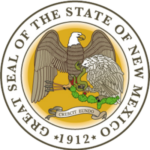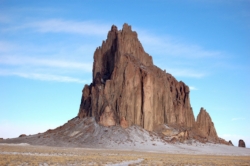New Mexico
New Mexico is a state located in the southwest and western regions of the United States. It is bordered by Arizona to the west, Colorado to the north, Oklahoma and Texas to the east, with Texas and Mexico to the south.
- ABBREVIATION: NM
- NICKNAME: The Land of Enchantment
- POPULATION: 2,085,287 (2013 est.)
- CAPITAL: Santa Fe
- STATE BIRD: Roadrunner
- STATE FLOWER: Yucca
- AREA: 121,589 sq. mi.
- TIME ZONE: Mountain
- ENTERED UNION: Jan. 6, 1912
- ALTITUDE: High, 13,167 ft. Wheeler Peak
- CLIMATE: Clean air, nearly constant sunshine, low humidity and little rainfall. Hot summers, winters generally mild.


New Mexico has plains so flat that “the water does not know which way to run when it rains”. The proud state of New Mexico is a spacious land of limestone caverns, mountain wilderness, high plateaus, and sweeping deserts which can be made fruitful only by irrigation. Yet New Mexico has supported mankind longer than almost any other area of the United States.
Thousands of years before Francisco Coronado led his 16th Century Spanish conquistadors into the sun-scorched land in search of the gold and silver of the mythical Seven Cities of Cibola, a civilization of Indians known as the Basket Makers quietly flourished in northwestern New Mexico region. Today, Pueblo Indians, who may be descendants of the Basket makers, live atop a 357-foot sandstone mesa near Albuquerque in the “sky city” of Acoma, the oldest continuously inhabited spot in the United States. In Santa Fe is one of the oldest churches in North America, the handsome mission-style San Miguel, built by Spanish padres in 1636. And in Santa Fe itself, inhabited at various times by Spaniards, Pueblos, and Mexicans, is the oldest capital north of the Rio Grande.

As in the rest of the Southwest, cattle, cotton, tourists, and mining-mostly potash, uranium, and petroleum-are major industries. But New Mexico’s open vastness has had an added spur to its economy. It was on the isolated mesa of Los Alamos, only 80 miles from Acoma, that man assembled his first atomic bomb, and it was equally isolated Alamogordo in the southern part of the state-in the region the Spanish called Jornada del Muerto (Dead Man’s Journey)-that the bomb was exploded in 1945. The state is now dotted with subsidiary defense industries, missile-testing sites and government laboratories, which give New Mexico a sizeable portion of its income. Recently this area has become the testing grounds for the new horizon of commercial space-flight. ‘Spaceport America’ is a spaceport located in the Jornada del Muerto desert basin, just west of the White Sands Missile Range. Soon Spacecraft will takeoff from the 10,000-foot-long runway to operate short commercial suborbital trips loaded with excited civilian ‘tourists’.
FUN FACTS:
- In terms of percent of its total population, New Mexico has more Native Americans and Hispanic people than any other state in the lower 48 (2012 est.).
- The largest gypsum dune field in the world is in White Sands National Monument.
- The ‘Big Room’, the largest underground chamber in Carlsbad Caverns National Park, is big enough to hold six football fields.
- The Roadrunner, New Mexico’s state bird, can reach ground speeds of 15 miles per hour.
- In 1950 the town of Hot Springs volunteered to change its name to ‘Truth or Consequences’. It is the only city in the country named for a game show. In 1950, Ralph Edwards, the host of the radio quiz show Truth or Consequences, announced that he would air the program from the first town that renamed itself after the show; Hot Springs won the honor. Edwards visited the town during the first weekend of May for the next 50 years. This event was called “Fiesta” and included a beauty contest, a parade, and a stage show.
- Santa Fe the highest capital city in the United States at 7,000 feet above sea level.
